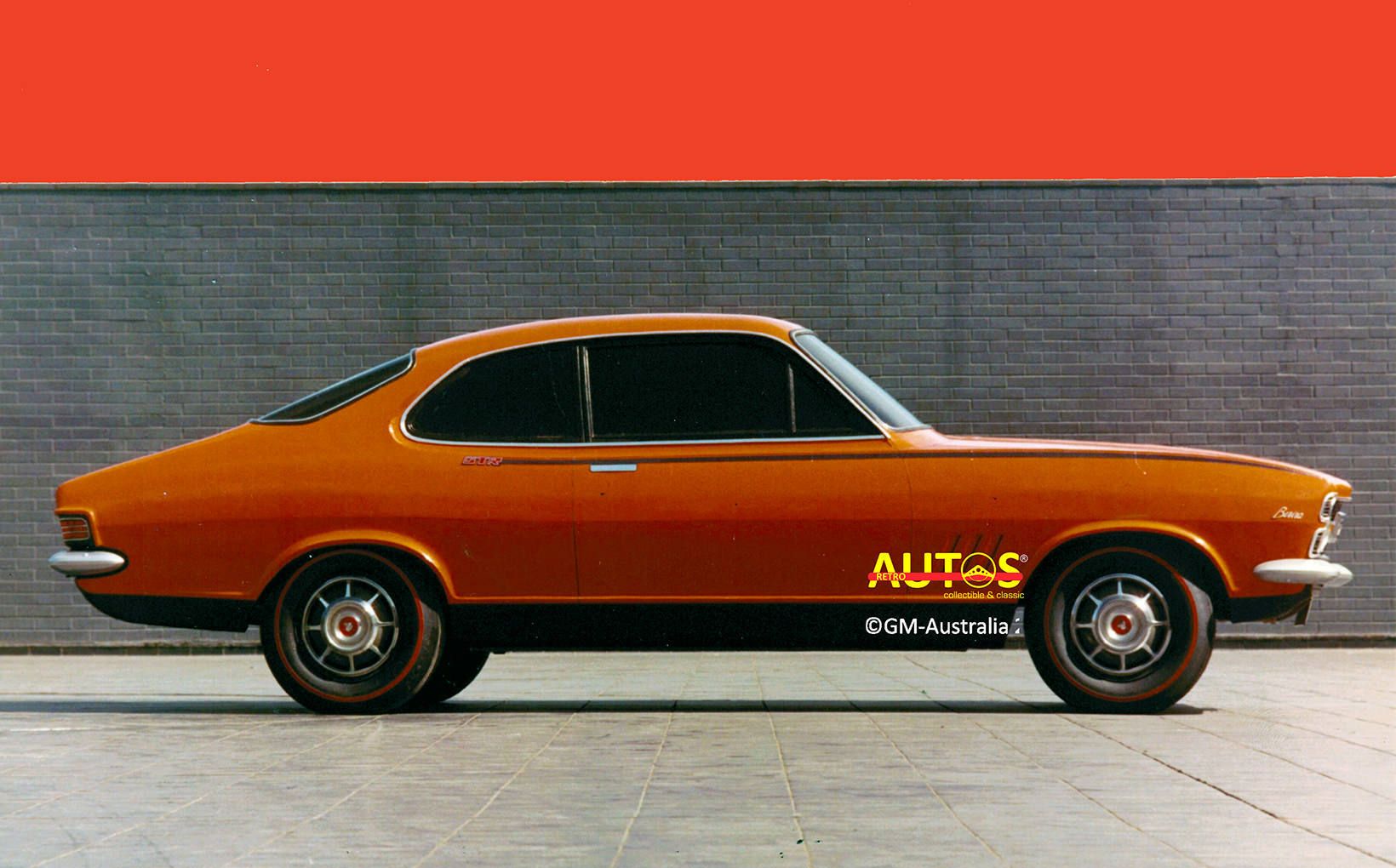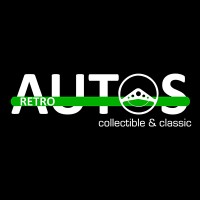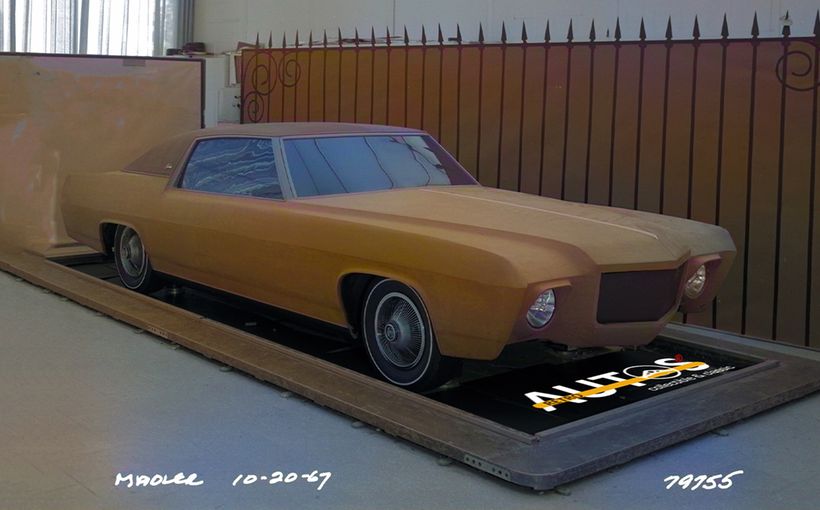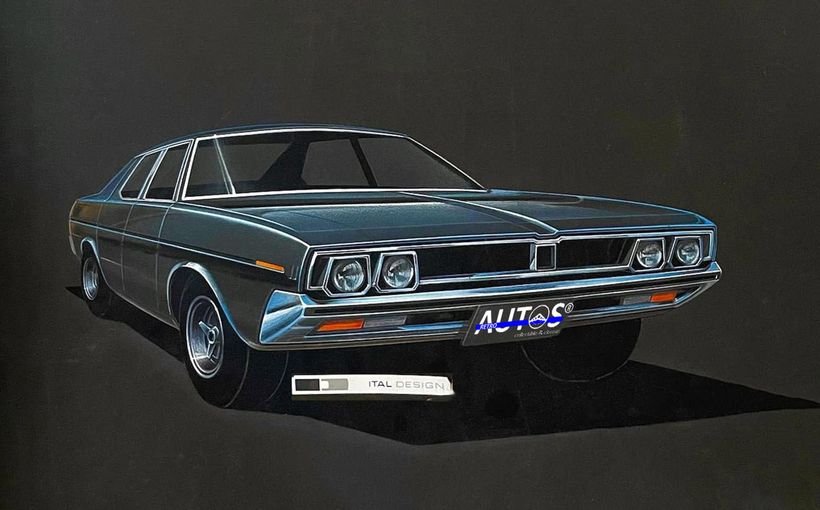
Let’s go back in time, through the high security doors and into the design studios at General Motors Holden (GMH) to find the previously secret photos of design proposals for the FJ, FE, HR, LC, HG, HQ and WB Holdens. These photos reveal the starting point of the shapes that have become embedded in our automotive heritage. Many have not been published before.

During the decades spanned by these images, GMH’s design efforts were led by Alf Payze, Joe Schemansky and Leo Pruneau. Alf was the chief stylist in the 1950s and early 1960s. Joe became the company’s first design director in April 1964. When Joe retired in 1975, Leo took over.
In the photos below, Alf is with General Motors (GM) design boss Bill Mitchell, standing next to the 1956 Oldsmobile Golden Rocket, now painted blue for reasons never known. Joe is seen with a HQ Premier and Leo with a LE Monaro. Joe’s career is showcased in the October 2020 edition of Retroautos®. Leo is featured in episode 1 of Shannons Design to Driveway. There are links at the end.



FJ: Less is More
In his book The FJ Holden, Don Loffler pinpoints September 1949 as when the FJ’s styling program commenced. The plan was for it to be released in mid-1952. An initial styling proposal was developed in Australia. Many sketches were made of possible grilles, some signed by Alf Payze. A 3/8th scale clay model was created featuring a new grille, one-piece curved windscreen and larger rear window.

The styling work then shifted to GM in Detroit where at least 12 full-sized grille proposals were developed. A one-piece windscreen was fitted to a 48-215. It was eliminated as too costly. A larger rear window mock-up was grafted onto another 48-215. It too was rejected because of costs. In March 1950 the production grille design was chosen. By August 1950 all of the FJ’s styling changes were confirmed, and that is when its release date was pushed beyond 1952.


With the 48-215 selling so well, and waiting list of over six months, Holden’s top executives reckoned there was no need for the FJ in 1952. They took a deliberate decision to delay its introduction until the 48-215’s waiting list had almost vanished. The public did not glimpse the “new” FJ until the last days of October 1953. As Don Loffler insightfully observed, it was:
“a 48-215, minimally but dramatically changed.”


FE: US design?
From a 21st century perspective it is difficult to understand the national anticipation which attached itself to the release of the FE Holden. In his book Heart of the Lion, Dr John Wright, captures the mood:
“The arrival of the FE was for most Australians the biggest automotive event of 1956. Here, at last, was a truly contemporary looking Holden. In country towns where the Holden dealership was often the focal point of the community, showrooms were papered over for days before to hide the glittering FE crouching within.”

There has always been conjecture about the origins of the FE design. Was it an all-Australian effort or was there some American involvement? Research by Dr Norm Darwin, and included in his book Early Australian Automotive Design, has revealed that the general shape of the FE originated in Detroit in late 1952.
When the FE Holden program began, Harley Earl was firmly in charge of GM’s styling efforts. However, he was focused on the American car market and spent little creative time considering what GM’s main outposts around the world were doing. Earl delegated this responsibility to Glen Smith, who travelled the world to ensure Earl’s design themes were followed.
The FE program started with several 3/8th scale clay models, built in Detroit, and then sent to Holden’s chief stylist, Alf Payze in Melbourne. Dr Darwin says that, during February 1953, Smith was in Australia discussing the proposals with Payze and senior Holden executives.
Alf and his team combined the scale model design themes into one full sized two-sided model. The left side had a straight belt line, while the right side had a small dip and kick up pressed into the sheet metal of the rear door. The final design of the FE emerged out of further refinement of the model’s right-side theme.




HR: Not so “Hastily Revised”

It is Australian automotive folklore that the 1966 HR Holden is the “Hastily Revised” successor to the “Horribly Designed” HD. Not so, as the evidence reveals.
In late 1963 Holden’s executives proposed that the HR should look almost identical to the HD. To save money there would be no sheet metal changes. So simple and minimal were the variations, that all the design team had to do was remove the grille and tail light lens from the existing fibreglass mock-up of the HD sedan and insert a revised grille, indicator lights and rear lights. Hey presto, the new HR! Another money saving idea was to paint the bumper bars in body colour.


That all changed when Joe Schemansky arrived to take up his role as design director in April 1964. Joe was already familiar with GMH. He’d visited Australia in mid to late 1963, sent by GM’s design boss, Bill Mitchell, to review GMH’s new model programs (especially the HR and HK), assess the capabilities of the local design team and to provide input into the new styling studios being constructed as part of GMH’s state-of-the-art Technical Centre.

Joe envisioned a much different HR than GMH’s conservative and cost focused executives. Not long after he’d flown back to Detroit, he had a tape drawing created. The photo, above, is dated 21st January, 1964. The new design involved sheet metal changes front and rear. As soon as he returned to Holden, Joe had a clay model built for comparison against the local proposal. In one of the last photos taken in the old design studio, in July 1964, the two HR proposals are compared. From there on, the HR shape continued to evolve. Nothing “hastily revised” at all.


The final HR design is captured in a staged publicity photo in the new GMH design studios. It shows Joe, and the newly arrived assistant design director, John Schinella, in earnest discussion, as members of the design staff attach the production HR grille to a clay model.

LC GTR fastback: The first Barina

This racy looking fastback coupe was designed by Phillip Zmood. Carrying “Barina” badges, it was seriously considered as a standalone GTR in the LC Torana line-up. The additional costs of tooling for a small volume coupe meant it went no further than what you see here. Phillip would succeed Leo Pruneau as GMH’s design director in 1983. Phillip’s career is featured in episode 3 of Shannons Design to Driveway. There is a link at the end of this story.


HG: Stop Gap

In 1965, GMH’s very secret product planning schedule listed the HK range for release in January 1968. The HT would follow in July 1969 and the HQ in January 1971.
Trouble was, by the end of 1968 the HQ’s development was running behind schedule and its release date was pushed into mid-1971. This meant that Holden faced the prospect of the HT being on the market for at least two years. To bridge the gap the HG was added to the schedule, for release in July 1970. There was almost no budget for the HG’s styling. Indeed, it was a re-run of the original plan for the HR. Just a new grille and tail light lens. Compare what was proposed with the production car.




HQ Statesman: Good to Great
Joe Schemansky worked for many years in the Pontiac and Cadillac styling studios. And the HQ Statesman is evidence of that! The split grille is pure Pontiac. The formal roof line and large rear fins are totally Cadillac.


These tape drawings from 1968 show, that in its initial styling phase, the Statesman was to share the Kingswood’s sloping rear fenders and integrated bumper bar. The introduction of the raised rear fenders took the car’s styling from good to great. Getting rid of the Brougham name was another smart idea.




WB wagons: no go


I’ve written extensively about the saga of the never released WB Kingswood/Premier in the October 2022 edition of Retroautos® (The link to that story is at the end.)
What you see here are the WB wagon proposals: Kingswood, Premier and Calais. All feature thick side mouldings, designed to hide the side body “eyebrows” that dominated the HQ, HJ, HX and HZ range. The photos of the Kingswood and Calais demonstrate the efforts of the design team to visually straighten the lines of the car, with the application of black paint and horizontal trim along the belt line, particularly at the rear door.



An alternative automotive heritage
These images reveal a fascinating alternative glimpse of what our automotive heritage may have looked like, had different decisions been made. There are so many “what if” questions to ask and answer!
Story links: Joe Schemansky, Leo Pruneau, Phillip Zmood, WB Holden.
Retroautos® is written and published by David Burrell with passion and with pride. Retroautos® stories and images are copyrighted. Reproducing them in any format is prohibited. Retroautos® is a registered trademark. Reproducing it in any format is prohibited. Special thanks to John Kyros at GM Heritage Centre who researched the Centre’s files, and to John Field and Richard Ferlazzo gave me access to Holden’s design studio archives a few years ago, so we can see these wonderful images.








